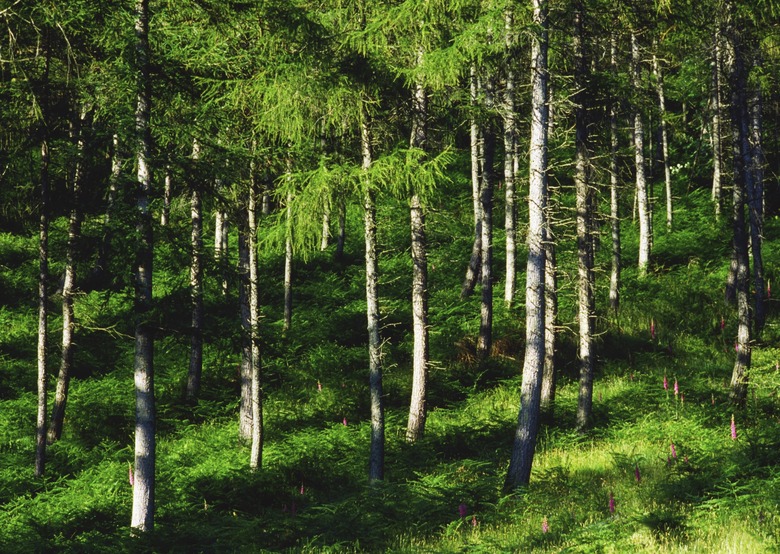The Life Cycle Of Gymnosperms
Gymnosperms encompass a diverse group of non-flowering plants that include conifers, cycads, ginkgoes and gnetophytes. Despite this diversity, there are some common factors in the life cycle of gymnosperms. Primarily, this group of plants produces male and female cones as part of the gymnosperm reproductive cycle but do not produce flowers or fruits. Gymnosperms take a uniquely long time to reproduce, since it often takes over a year from the time pollination occurs until fertilization is complete. Once seeds are produced, some species may hold their seeds until very specific conditions are met. Even then, they can lie dormant for several more years before germinating.
Gymnosperm Diversity
Gymnosperm
Diversity
Gymnosperms are an ancient and diverse group of vascular plants that existed prior to the evolution of flowering plants, or angiosperms. The largest subgroup are the conifers, which include pine, fir, spruce and cypress trees. Instead of the needles of the conifers, cycads have large, fern-like leaves. While common during the age of dinosaurs, there are fewer species of cycads around today. Ginkgoes were also much more common when dinosaurs lived. Gingko biloba, with its fan-shaped leaves, is one of the few surviving species. Lastly, the gnetophytes, or gnetales, are a small subgroup that produce leaves and have some angiosperm characteristics but are classified as gymnosperms.
Development of Egg and Sperm Cells in Gymnosperms
Development of Egg and Sperm Cells in Gymnosperms
Like many plants, they experience alternation of generations, which means the life cycle of gymnosperms includes both diploid and haploid stages. In the diploid stage, cells have two sets of chromosomes, The male diploid gametophyte in the gymnosperm reproductive cycle is a pollen grain with two sets of chromosomes called a microspore. A gametophyte gives rise to the gametes, or sex cells. Microspores are stored in specialized leaves called sporophylls, groups of which are formed into pollen cones. The female diploid gametophyte is called a megaspore. The sporophyll storing the megaspore makes up a single scale on a pinecone. Both the microspore and megaspore develop into haploid gametes – egg and sperm cells – after undergoing meiosis.
Pollination Leads to Fertilization
Pollination Leads to Fertilization
In the haploid stage of the gymnosperm life cycle, the plants have only one set of chromosomes. Haploid microspores are released into the air as pollen. When the pollen lands on an ovulate cone, a pollen tube forms and the nucleus of the sperm cell discharges through the pollen tube into the haploid female gametophyte containing the egg. Fertilization occurs when the haploid egg and sperm cells combine to form a diploid embryo, which will have one set of chromosomes from the male contributor and one set of chromosomes from the female contributor. Fertilization usually occurs more than a year after pollination.
Seed Development and Dispersal
Seed Development and Dispersal
In life cycle of a pine tree, the pine embryo is the new sporophyte. It contains a rudimentary root and some embryonic leaves called cotyledons. The female gametophyte surrounds the embryo and provides a food supply as it develops. This ovule forms the pine seed, which contains the embryo, its food supply, and a protective seed coat that forms from the integuments of the parent sporophyte. Under proper conditions, pine cone scales open to release their seeds. Some pine seeds are winged and can be dispersed by wind, while others require high heat, such as a forest fire, to open and release their seeds. Still others will readily drop the seeds once they are mature.
Completing the Gymnosperm Reproductive Cycle: Germination
Completing the Gymnosperm
Reproductive Cycle:
Germination
After the seeds have been fertilized, matured and dispersed, the ripe seed must be exposed to the proper conditions in order to germinate. In some species, mature seeds may lie dormant for years, ready to germinate when they have adequate moisture, the proper temperature, adequate gas exchange and exposure to sunlight. In the life cycle of a pine tree, once the seed germinates, it forms a pine seedling that grows into a mature pine tree, and the cycle starts again.
Cite This Article
MLA
Reid, Ari. "The Life Cycle Of Gymnosperms" sciencing.com, https://www.sciencing.com/life-cycle-gymnosperms-5456257/. 12 October 2018.
APA
Reid, Ari. (2018, October 12). The Life Cycle Of Gymnosperms. sciencing.com. Retrieved from https://www.sciencing.com/life-cycle-gymnosperms-5456257/
Chicago
Reid, Ari. The Life Cycle Of Gymnosperms last modified March 24, 2022. https://www.sciencing.com/life-cycle-gymnosperms-5456257/
